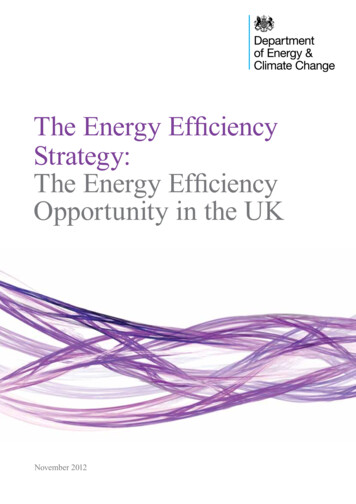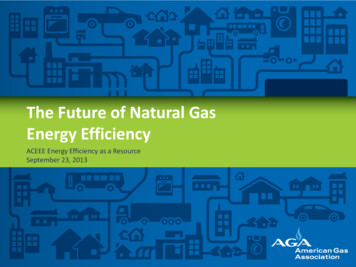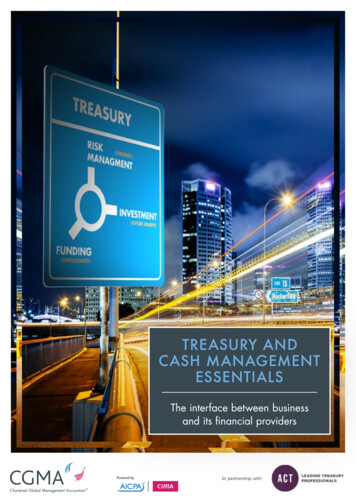
Transcription
The Energy EfficiencyStrategy:The Energy EfficiencyOpportunity in the UKNovember 2012
The Energy EfficiencyStrategy:The Energy EfficiencyOpportunity in the UKNovember 2012
Department of Energy and Climate Change3 Whitehall PlaceLondon SW1A 2AWTelephone: 0300 060 4000Website: www.decc.gov.uk Crown copyright 2012Copyright in the typographical arrangement and design rests with the Crown.This publication (excluding logos) may be re-used free of charge in any format or medium provided that itis re-used accurately and not used in a misleading context.The material must be acknowledged as crowncopyright and the title of the publication specified.For further information on this document contact:Energy Efficiency Deployment OfficeDepartment of Energy and Climate Change3 Whitehall PlaceLondon SW1A 2AWEmail: eedostrategy@decc.gsi.gov.ukThis publication can be found on DECC’s website:http://www.decc.gov.uk/eedoPublished by the Department of Energy and Climate Change
The Mission Improving our energy efficiency is a key strategic objective for the Coalition Government.It is fundamental to decarbonising the UK, maintaining secure energy supplies, andincreasing the productivity of our businesses. We have a proud history of making the verymost of our resources and energy should be no different. This Coalition Government has a mission to seize the energy efficiency opportunity,accelerating the deployment of twenty-first century energy saving measures through:–– connecting energy efficiency knowledge and technologies to finance seeking strongreturns;–– supporting energy efficiency innovation;–– harnessing the power of improved energy use information, driving its availability anddisclosure; and–– encouraging collective action to act on this new and better information. As set out in this strategy the benefits to energy efficiency can be significant, including:–– boosting growth and creating jobs in our economy;–– saving households and businesses money on fuel bills;–– creating a more sustainable and secure energy system;–– delivering cost effectively against our climate change goals; and–– reducing energy imports. The December 2011 Carbon Plan was clear that, if we are to cut our green house gasemissions by 80% by 2050, ‘energy efficiency will have to increase dramatically across allsectors’. It set out four possible scenarios for 2050, relative to 1990, which imply a percapita demand reduction of between 31% and 54% relative to 2007. This Government has already made progress through radical initiatives such as the GreenDeal, but this Strategy pinpoints the remaining energy efficiency potential within the UKeconomy and summarises the actions we will now take to realise this.
iContentsMinisterial Foreword1Clarification of scopeThe Energy Efficiency Deployment Office (EEDO)Devolution333The Energy Efficiency Opportunity in the UK5Understanding energy efficiency6The energy efficiency opportunity7Energy efficiency potential in the UK economy8The benefits of energy efficiency8Our ambition for improving energy efficiency15The barriers to deploying energy efficiency18Maximising the potential of existing schemes20An energy efficient future22The annexes to this strategy can be found at http://www.decc.gov.uk/eedo
ii Energy Efficiency Strategy:The Energy Efficiency Opportunity in the UK
1Ministerial ForewordEnergy efficiency belongs at the heart of alow-carbon economy. By reducing energy useand cutting down on waste, we can reduceenergy bills, make our energy system moresustainable, and drive down greenhousegas emissions.Too often, governments have neglected the rolethat energy demand reduction can play inmanaging our energy system.Yet measures thatreduce demand can contribute in a morecost-effective way to meeting our energy andclimate goals than supply-side measures.That’swhy energy efficiency – as a way of reducingdemand – takes pride of place at the centre ofthe Coalition Government’s policy framework.I want Britain to get as close as possible to usingonly the energy we really need. We could besaving 196TWh in 2020, equivalent to 22 powerstations through, socially cost-effectiveinvestment in energy efficiency.That is around11% lower than the business as usual baseline.It could also reduce carbon emissions by41 MtCO2e, contributing to achieving ourcarbon budgets.Britain’s homes have been built and developedover hundreds of years, and their energyefficiency varies from good to dreadful. Bringingas many homes as possible up to the level ofthe best is not only a worthwhile investment;it also presents a huge business opportunity,including a chance for British companies todevelop expertise which can be exported tooverseas markets.This strategy sets the direction for energyefficiency policy for the coming decades.It makes clear our ambition, the barriers that weneed to address, and the additional steps we aretaking now to stimulate the energy efficiencymarket. It shows how we will act to connectfinance with demand, encourage innovation, andmake energy efficiency information moreaccessible to the consumer.Energy efficiency can reduce energy bills forhouseholds and businesses, and can boost theeconomy in a sector with great potential forfuture growth, driving innovation in the process.The prospect of achieving more with lessenergy is an exciting one, and this strategy setsout the opportunity in full.Edward DaveySecretary of State for Energy andClimate Change
2 Energy Efficiency Strategy:The Energy Efficiency Opportunity in the UK
3Clarification of scopeThe Energy EfficiencyDevolutionDeployment Office (EEDO) Any development of policy in the area of energyEEDO has developed this Strategy, drawingfrom expertise across Government andconsidering energy efficiency potential acrossthe UK economy, including in businesses,buildings, products and transport. It is the first ina series of documents that EEDO will produce.EEDO has been set up within DECC to supportthe delivery of our existing energy efficiencypolicies, by improving our evidence base andanalysis, ensuring effective delivery against theobserved energy efficiency potential in theeconomy, and by bringing coherence to theGovernment’s offer to the consumer.Beyond DECC, EEDO forms an inclusiveinitiative with UK Government Departments,the Scottish and Welsh Governmentsrepresented on its quarterly Steering Board andNorthern Ireland having observer status. As theevidence base is developed, the objective will beto share information, by region and sectorswhere possible, and consider solutions toachieving further energy efficiency potential as agroup.efficiency needs to take into account thefollowing arrangements: that, in Scotland1 and Wales, theencouragement of energy efficiency isdevolved, while the regulation of energyefficiency is reserved; and that the promotion and regulation of energyefficiency is devolved to Northern Ireland.Furthermore, as policy ideas in this Strategy aredeveloped they will need to take account ofwhere they may impact on other policy areasthat are devolved to Scotland and Wales.Northern Ireland are able to draw from EEDO’swork as it considers its own future energyefficiency policy.This approach is reflected in this Strategy, withdifferences between the policy frameworks ofdevolved Governments clearly referenced.1 Low Carbon Scotland, the Scottish Government’s first report on proposals for meeting the annual climate changetargets set under the Climate Change (Scotland) Act /climatechange/scotlands-action/lowcarbon/rpp
5The Energy EfficiencyOpportunity in the UK1. The UK now has a huge opportunity tooptimise the energy use of both domestic andbusiness customers, reducing bills and/orwarming homes, while at the same time,delivering a more sustainable society. Individualscan do this through taking action to reduce theirdemand, such as turning off energy usingproducts that are not in use, buying productsthat are more efficient or installing energyefficiency measures in their homes. Businessescan take similar actions, reducing their long termoperating costs.The critical importance ofenergy efficiency to our long-term energy policyis reflected in last December’s Carbon Plan2.3. This strategy identifies four overarchingbarriers to greater energy efficiency that have tobe overcome. Action is already being taken, but ifwe further pursue these barriers we will be abledevelop a stronger, self sustaining energy efficiencymarket and more consumers will be able to see areturn, creating positive reinforcement of thepotential of energy efficiency.The fourcorresponding ‘barrier annexes’ to this strategy5outline those policies that are already in place totackle these issues and provide case studies wherepublic and private sector organisations havealready been successful in achieving greaterenergy efficiency, realising the associated benefits.2. Many of the views received in response to theFebruary 2012 Energy Efficiency Call for Evidence3,4recognised huge potential but asked for greatercertainty on what was needed to improve ourenergy efficiency at a national level.This responsesets out the long term direction required as well asspecific actions that will be taken now.4. Our broad assessment of the policyframework is that the energy efficiency agenda forhouseholds is well covered by existing initiatives,although there is still a need to maximise the waythese policies work.There is, however, particularfurther interest in significant commercial andindustrial energy efficiency potential not alreadycovered by the existing policy.“This is an Energy Efficiency Strategy to maximiseexisting policy and realise the wider energy efficiencypotential that is available in the UK economy.”23456“We estimate that through socially cost-effectiveinvestment in energy efficiency we could be saving196TWh in 2020, equivalent to 22 power stations6,7”.Carbon Plan, DECC, December 2011Energy Efficiency Call for Evidence, DECC, 8 February 2012.The Government’s Call for Evidence summary of responses can be found at Annex F of this strategy.Annexes A-D.The costs and benefits of measures have been calculated from the societal perspective, in line with the appraisal guidanceset out in the Green Book and the supplementary guidance provided by the Inter-departmental Analysts’ Group on valuingcarbon emissions avoided, energy savings and air quality improvements. This means that the value of energy savings isbased on the resource costs, not the retail price (and non-traded carbon emissions and air quality impacts are included).Capital costs are assumed to be paid upfront and financing costs are excluded. The costs and benefits are discounted overtime at the social discount rate. A measure that is cost-effective from the societal perspective may not be cost effective forthe individual investor. For more detail on the methodology of the EE-MACC, see Annex E.7 Assumption of a power station with 1 GW capacity operating full-time.
6 Energy Efficiency Strategy:The Energy Efficiency Opportunity in the UK5. The potential for the 2020s is even greater.Considered in this way, energy efficiency canplay a major role in the UK’s balancing of energydemand and supply.6. Box 1 provides a summary of additionalactions we are taking alongside this strategy inorder to help stimulate a self sustaining energyefficiency market.These actions and othersacross the broad energy efficiency spectrumare covered in more detail within the barrierannexes.Understanding energyefficiency“Energy efficiency is a measure of energy usedfor delivering a given service. Improving energyefficiency means getting more from the energythat we use.”7. There are different ways to improve energyefficiency. For example: ‘Innovation’ can lead to the equal or greateroutput with less energy. ‘Cutting out wasted energy’ reduces energyneeded while maintaining output.Box 1: Further action taken as part of this Energy Efficiency Strategy A key focus is supporting the finance market through: publishing guidance on financingenergy efficiency for the public sector; announcing a research project with ENWORKS tounderstand the process, costs and benefits of financed energy efficiency projects; initiatingan assessment of compatibility of energy efficiency investments with the public sectorbudgeting framework; taking the RE:FIT programme, which facilitates the public sector useof the ESCO market, nation-wide and the Electricity Demand Reduction project. We are going further on energy efficiency innovation by: announcing three new ‘energyefficiency’Technology Innovation Needs Assessments (TINAs); sponsoring three newenergy efficiency Green Business Awards; and, reviewing the way that new innovativeenergy efficiency measures are reviewed and accredited. We are working to strengthen the evidence base through: commissioning research into thepotential of advanced heating controls; working with the IEA to explore all benefits of energyefficiency; setting out a future DECC Evidence Strategy; and co-ordinating with ResearchCouncils UK and others, to support the development of a knowledge hub for the refurbishmentof existing homes as well new Energy Demand Research Centres, announced with this strategy. A further focus area is controls and information, where we will: launch a behavioural trialwith the John Lewis Partnership on whether providing information on lifetime electricityrunning costs helps consumers; making funding available to increase the proportion offacilities managers receiving specialist energy efficiency training; develop a trial to study theimpact of advice on how to use heating controls provided when boiler checks are carriedout; and announce a forthcoming DECC Community Energy Strategy as well ascommission a Community Energy Efficiency Outreach Programme with Groundwork UK. Within audits and standards, we will focus on: beginning the process for implementingenergy audits for non-SME enterprises, as required by the Energy Efficiency Directive; andseeking the ISO50001 Energy Management Standard accreditation for DECC.
The Energy Efficiency Opportunity in the UK 7 ‘Heating technologies’, such as heat pumps,can deliver greater output for less supplierenergy.8. Through greater energy efficiency we canuse less primary fuel or power to enjoy thesame level of output. For example, by improvingmanufacturing equipment it is possible toproduce the same or more with loweroverheads. Improved energy efficiency canprovide many economic, social andenvironmental benefits for the UK and yet weare not doing all we can to realise them.9. Clearly, this is not a new policy agenda.The first energy demand reduction policieswere developed by the Department of Energyin 1974 in response to oil shocks and manydifferent approaches have been taken since toimprove our energy use efficiency, with somesuccess8. Approaches have changed, as have theways in which we have used energy, but therehas never been a quick fix. So why an EnergyEfficiency Strategy now?10. We must continue to find solutions, suchas those provided by the Green Deal and SmartMeters, which allow us to tap into the costeffective energy efficiency improvements thatare right there in front of us; whether it bethrough more efficient industrial processes,better use of heat, or simply installing energyefficient lighting.The energy efficiencyopportunity11. The energy efficiency sector in the UKalready accounts for about 136,000 jobs andhad sales of 17.6 billion in 2010/11. Sales in thissector have grown by over 4% per year in theUK since 2007/08, and are projected to growby around 5% per year between 2010/11 and2014/15. However, there is more potential inthe market9.12. Stephen Chu, the US Secretary of Energy,has said that “energy efficiency is not justlow‑hanging fruit; it is fruit that is lying on theground”10. With the right market in the UK wecould unlock more of the potential for energyefficiency investment, helping to generategrowth and jobs. Alongside the associatedcarbon reductions, improvements in our energysecurity by reducing demand for importedBox 2:Why now?There are good reasons to set the direction on improving energy efficiency in the UK: finding ways to do more (or the same) with less makes economic sense; it can help households and businesses reduce their energy bills at a time of increasingenergy prices; many energy efficiency improvement schemes are approaching implementation and weneed to clearly set out the linkages and the collective ambition; we need to be clear as to the role of demand side management as our electricitygeneration market is reformed; and energy efficiency needs to be taken forward as a cost effective solution to carbonreduction to meet our carbon budgets.8 See Figure 3 for the trend of consumption per capita in the UK.9 K-Matrix, Low Carbon and Environmental Goods and Services data (2010-11).The energy efficiency sector has beendefined as the energy management and building technologies data10 Steven Chu,The Times, London, 26 May 2012.
8 Energy Efficiency Strategy:The Energy Efficiency Opportunity in the UKenergy, warmer homes and lower resultingenergy bills mean increasing energy efficiency iswin-win-win. We must, and will, make it happenin the UK. Greater energy efficiency may alsosupport improvements in wider resourceefficiency.Energy efficiency potential in theUK economy13. Responses to the Energy Efficiency Callfor Evidence highlighted the significant energyefficiency potential in the UK economy anddetailed analysis confirms that there is significantcost effective potential.The Energy EfficiencyMarginal Abatement Cost Curve (EE-MACC)estimates the energy savings throughimplementing energy efficiency measures.It is based on detailed modelling of ambitiousscenarios for the potential for investment inenergy efficiency from different sectors of theeconomy, based on current evidence.The morecost-effective a measure, the closer it is to theleft-hand side of the chart. For more detail onthe methodology and assumptions see Annex E.14. We estimate that through socially costeffective investment in energy efficiency wecould be saving 196TWh in 2020, equivalent to22 power stations11,12. Were all this potential tobe realised, final energy consumption in 2020could be 11% lower than the business as usualbaseline.This potential can be found across theUK economy and realising this could havesignificant benefits for businesses andhouseholds. For example, the EE-MACC analysissuggests there is potential for cost effectiveenergy efficiency in commercial buildings andindustry over and above that which we expectto be realised through policies such as theEU-ETS, CCAs or CRC (DECC analysis suggeststhat around 14% of total energy use in thebusiness and public sector are in organisationsthat are not included in these policies).15. Further, there is the potential to saveenergy through changing how we use it, both indomestic and business settings, while maintainingthe benefits delivered.This potential is notfully captured within the framework of theEE-MACC. Developing a stronger understandingof the potential for energy efficiency andevaluating the impact of policy on incentives toinvest in energy efficiency is a priority for EEDO.As the evidence base improves, the detailedassessment what the potential is for energyefficiency investment may be adjusted.The benefits of energy efficiency16. Economic growth: Installing energyefficiency measures often requires local labour13,and the investment has the potential to boostemployment and economic growth. Thebusiness community see this as important in thecurrent global economic climate14,15. There arealso long-term growth benefits. For example,lower domestic energy bills can lead to higherdisposable incomes that can be spent elsewherein the economy, while businesses can see areduction in running costs and so an increasein productivity. Simple changes in energy use11 The costs and benefits of measures have been calculated from the societal perspective, in line with the appraisalguidance set out in the Green Book and the supplementary guidance provided by the Inter-departmental Analysts’Group on valuing carbon emissions avoided, energy savings and air quality improvements . This means that the valueof energy savings is based on the resource costs, not the retail price (and non-traded carbon emissions and airquality impacts are included).The capital costs are assumed to be paid up front and financing costs are not included.The costs and benefits are discounted over time at the social discount rate. A measure that is cost-effective from thesocietal perspective may not be cost effective for the individual investor (and vice versa).12 Asssumption of a power station with 1 GW capacity operating full-time.13 Last year Groundwork, a third sector organisation, helped 4,200 people progress into training, education oremployment, many of them into ‘green jobs’(see Annex D for more detail).14 Economist Intelligence Unit, Energy Efficiency and energy savings: a view from the buildings sector, October ads/Report EIU GBPN.pdf15 The colour of growth: Maximising the potential of green business, CBI, July 2012.
50100150250300Energy savings in2020 TWhDomesticCommercial and public sectorIndustryTransportProductsFor details of the measures seeFigure E1 in Annex E200Notes:For more detail on the methodology and assumptions see Annex E consistent with the 2012 DECC energy projections and supplementary Green Book Guidance appraisal guidance. The business as usual baselineexcludes policies that have been introduced since 2009.The net present values are calculated in 2012 terms.Products policy estimates become increasingly uncertain beyond 2020, where the market may naturally deliver more efficient products – this will be reviewed in future. The energy savings from Tranche 1 and 2 ofproducts policy within the industrial sector have been included in the potential for energy savings in industry.Smart meters estimates are consistent with cost and savings assumptions as applied in the smart meter impact assessment and costs required for the delivery of the policy are taken into account (i.e. not only theasset costs for the provision of the technology are reflected).To be consistent with the methodology used here, financing costs have been excluded.The transport analysis is consistent with that included in the Carbon Plan (December 2011).The assumptions, on fuel prices and growth for example, have not been revised since.Estimates for the energy savings from CERT (20% uplift and extension) and CESP are consistent with the projected net energy savings set out in the DECC energy projections.The estimates of energy savings is netof comfort taking, but we have not valued comfort taking for these measures. The NPV for these policies is estimated based on discounting to 2009.-150-100-500Cost effectiveness as measured by NPV/lifetime energy savings /MWh50Figure 1: 2020 Energy Efficiency Marginal Abatement Cost CurveThe Energy Efficiency Opportunity in the UK 9
16 K-Matrix, Low Carbon and Environmental Goods and Services data (2010-11).The figure shows the size of UK Energy Efficiency Sector exports in 2010/11 to 50 othercountries. These are the countries with the highest sales from their own Low Carbon and Environmental Goods and Services sectors, based on when the data seriesstarted in 2007/08.Exports from the UK Energy Efficiency Sector in 2010/11 were worth 1.8 billionFigure 2: UK energy efficiency exports in 2010/111210 Energy Efficiency Strategy:The Energy Efficiency Opportunity in the UK
The Energy Efficiency Opportunity in the UK 11behaviour can deliver some of these benefitswith little up-front cost. Arup carrying out energy efficiency auditwork on university campuses in the USA.17. Longer term investment in energyefficiency technology can also lead to a virtuouscircle as innovation leads to cost reductionswhich can make it cheaper and easier to investin energy efficiency in the future. Developingour innovative capacity in technology, materialsor business models for energy efficiency opensup the potential for increasingly significantexport opportunities for the UK as the globaleffort to combat climate change ramps up. The BRE (Building Research Establishment)are working with partners in China and Brazilto develop Green Building DemonstrationParks where UK companies can showcasetheir world-class building techniques,products and services for homes andcommunities and help set the standardfor sustainable development.18. Thinking more broadly than headlineexport figures, we can see real examples of UKexpertise shaping people’s approach to energyefficiency across the globe. For instance: Mark Group using the know-how developedover four decades in the UK to establishsuccessful energy saving operations in theUSA, Australia and New Zealand. CO2 balance supporting the distribution ofenergy efficient stoves in Tanzania.19. Economic studies show that improvedenergy efficiency can bolster productivity,increasing growth and reducing inflation. A studyof the Government’s energy efficiency policybetween 2000-2007 estimated that thesepolicies increased the annual rate of economicgrowth by around 0.1 percentage pointswithin that period17. The study also estimatedthat these policies resulted in roughly 270,000additional jobs in 2010 owing to thecumulative impact of higher growth. Lookingforward, DECC analysis suggests that theBox 3: Energy efficiency and the DECC fuel poverty strategy for EnglandTackling fuel poverty is about helping people on low incomes who cannot keep warm atreasonable cost.There is some evidence that certain vulnerable groups, such as householdswith older people and children, can be the most at risk of health detriments associated withcold homes, such as respiratory illnesses. Energy efficiency has a clear role to play in assistingthese households, insulating them from the cold as well as the effects of rising energy prices.Earlier this year, Professor John Hills published his review of fuel poverty. In it he proposed anew framework for measuring fuel poverty, which the Government has announced it intendsto adopt subject to the outcome of an ongoing consultation.The Government also announcedit would publish a new fuel poverty strategy in 2013.Under the proposed new measurement approach, a household is fuel poor if it is low incomeand has high energy costs relative to all other households. A key factor driving energy costsis, of course, energy efficiency. As such, the Government’s new strategy will set out howenergy efficiency improvements can be made in such households, to provide a sustainablemeans of reducing costs.17 Barker,T., Ekins, P., & Foxon,T. (2007).The macro-economic rebound effect and the UK economy. Energy Policy,4935-4946.
12 Energy Efficiency Strategy:The Energy Efficiency Opportunity in the UKGreen Deal and ECO alone could supportup to 60,000 jobs across the UK in 201518.20. Savings for domestic and businessconsumers: As highlighted as part of therecent ‘Big Energy Saving Week’, improving theUK’s energy efficiency is central to deliveringa fair deal for the consumer. UK householdsare already benefitting from improvements inenergy efficiency such as heating efficiencyand insulation. Building Research Establishmentmodelling suggests that, if no energy efficiencygains had been made since 1970, current energyuse would be almost double their current levels,adding about 1,000 to the average annualenergy bill19. Energy efficiency will continue tohave a role in driving long term reductions inhousehold energy bills.21. Wellbeing can also be enhanced throughincreased energy efficiency. For example, ahigher disposable income, as a result of lowerenergy bills, can allow increased spending onother necessities. In addition, the health benefitsfrom properly installed energy efficiencymeasures can be significant. It is possible toquantify health benefits in quality of life terms, inline with the principles of the Department ofHealth/NICE guidance. DECC modelling of theimpact of the installation of solid wall insulationin all properties in England, gives a totalimprovement in the health of those individualsin the properties of 3.5bn – 5.0bn over thelifetime of the measures. If all cavity wallsreported unfilled in 2009 were also filled thiswould provide a further monetised healthbenefit of 4bn – 6bn over lifetime of theinsulation20.22. Some of the financial savings from energyefficiency measures may be spent on energyconsuming goods and services: the reboundeffect.This means that the overall impact onenergy consumption is smaller, althoughconsumers may feel a benefit from theadditional energy consumption. The nature ofrebound effect will vary depending on theenergy efficiency measures adopted. Forexample if someone increases the level ofinsulation in their property, the direct reboundeffect would be an increase in the temperatureto which the house is heated and an indirectrebound effect would be using the savings onheating bills to buy an additional television. It ispossible that the direct rebound effect might bereduced through providing advice when energyefficiency measures are installed.23. Energy efficiency is also one of the centralpillars of the Government’s efforts to tackle fuelpoverty. Improving the energy efficiency of thehome is often the most cost-effective way ofmaking a sustained reduction in householdheating costs and removing that household fromfuel poverty. Professor John Hills’ Review of FuelPoverty in England21 included a consideration ofthe role of energy efficiency in helpingvulnerable groups (see box 3).24. Emission reductions: To deliver against ourgreenhouse gas emission targets over thecoming decades in the most c
The Mission Improving our energy efficiency is a key strategic objective for the Coalition Government. It is fundamental to decarbonising the UK, maintaining secure energy supplies, and










